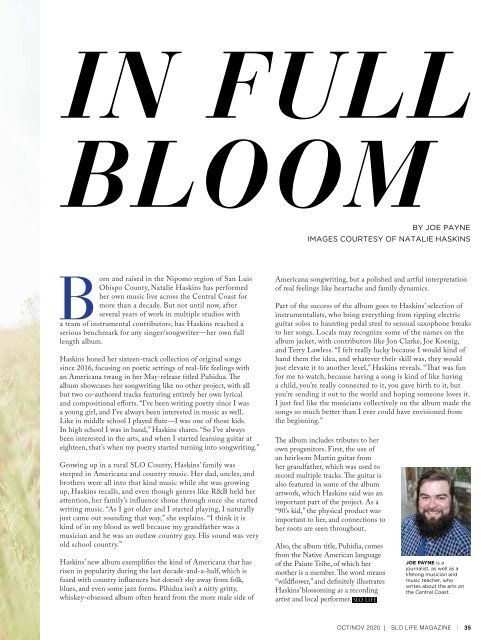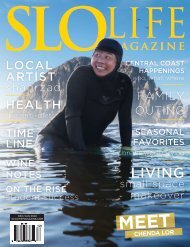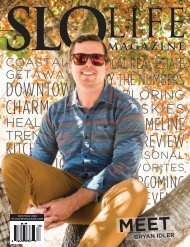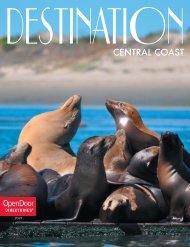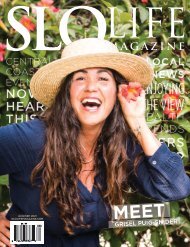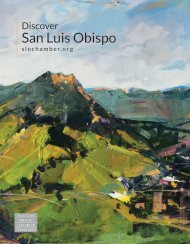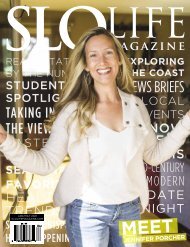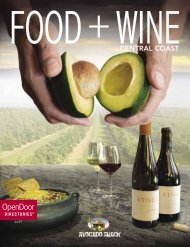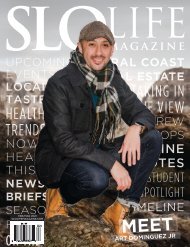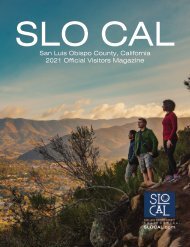SLO LIFE Oct/Nov 2020
You also want an ePaper? Increase the reach of your titles
YUMPU automatically turns print PDFs into web optimized ePapers that Google loves.
IN FULL<br />
BLOOM<br />
BY JOE PAYNE<br />
IMAGES COURTESY OF NATALIE HASKINS<br />
Born and raised in the Nipomo region of San Luis<br />
Obispo County, Natalie Haskins has performed<br />
her own music live across the Central Coast for<br />
more than a decade. But not until now, after<br />
several years of work in multiple studios with<br />
a team of instrumental contributors, has Haskins reached a<br />
serious benchmark for any singer/songwriter—her own full<br />
length album.<br />
Haskins honed her sixteen-track collection of original songs<br />
since 2016, focusing on poetic settings of real-life feelings with<br />
an Americana twang in her May-release titled Puhidua. The<br />
album showcases her songwriting like no other project, with all<br />
but two co-authored tracks featuring entirely her own lyrical<br />
and compositional efforts. “I’ve been writing poetry since I was<br />
a young girl, and I’ve always been interested in music as well.<br />
Like in middle school I played flute—I was one of those kids.<br />
In high school I was in band,” Haskins shares. “So I’ve always<br />
been interested in the arts, and when I started learning guitar at<br />
eighteen, that’s when my poetry started turning into songwriting.”<br />
Growing up in a rural <strong>SLO</strong> County, Haskins’ family was<br />
steeped in Americana and country music. Her dad, uncles, and<br />
brothers were all into that kind music while she was growing<br />
up, Haskins recalls, and even though genres like R&B held her<br />
attention, her family’s influence shone through once she started<br />
writing music. “As I got older and I started playing, I naturally<br />
just came out sounding that way,” she explains. “I think it is<br />
kind of in my blood as well because my grandfather was a<br />
musician and he was an outlaw country guy. His sound was very<br />
old school country.”<br />
Haskins’ new album exemplifies the kind of Americana that has<br />
risen in popularity during the last decade-and-a-half, which is<br />
fused with country influences but doesn’t shy away from folk,<br />
blues, and even some jazz forms. Pihidua isn’t a nitty gritty,<br />
whiskey-obsessed album often heard from the more male side of<br />
Americana songwriting, but a polished and artful interpretation<br />
of real feelings like heartache and family dynamics.<br />
Part of the success of the album goes to Haskins’ selection of<br />
instrumentalists, who bring everything from ripping electric<br />
guitar solos to haunting pedal steel to sensual saxophone breaks<br />
to her songs. Locals may recognize some of the names on the<br />
album jacket, with contributors like Jon Clarke, Joe Koenig,<br />
and Terry Lawless. “I felt really lucky because I would kind of<br />
hand them the idea, and whatever their skill was, they would<br />
just elevate it to another level,” Haskins reveals. “That was fun<br />
for me to watch, because having a song is kind of like having<br />
a child, you’re really connected to it, you gave birth to it, but<br />
you’re sending it out to the world and hoping someone loves it.<br />
I just feel like the musicians collectively on the album made the<br />
songs so much better than I ever could have envisioned from<br />
the beginning.”<br />
The album includes tributes to her<br />
own progenitors. First, the use of<br />
an heirloom Martin guitar from<br />
her grandfather, which was used to<br />
record multiple tracks. The guitar is<br />
also featured in some of the album<br />
artwork, which Haskins said was an<br />
important part of the project. As a<br />
“90’s kid,” the physical product was<br />
important to her, and connections to<br />
her roots are seen throughout.<br />
Also, the album title, Puhidia, comes<br />
from the Native American language<br />
of the Paiute Tribe, of which her<br />
mother is a member. The word means<br />
“wildflower,” and definitely illustrates<br />
Haskins’ blossoming as a recording<br />
artist and local performer. <strong>SLO</strong> <strong>LIFE</strong><br />
JOE PAYNE is a<br />
journalist, as well as a<br />
lifelong musician and<br />
music teacher, who<br />
writes about the arts on<br />
the Central Coast.<br />
OCT/NOV <strong>2020</strong> | <strong>SLO</strong> <strong>LIFE</strong> MAGAZINE | 35


